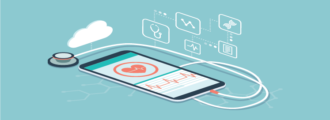Medical charting is an essential, yet usually very time-consuming, procedure for all healthcare providers. But, what if we told you there was an electronic charting software that allows you to ditch your outdated clinical documentation tools and start charting more efficiently?
Luckily for you, there is. Cue the Epic Charting System.
Epic Charting offers a seemingly endless list of features and benefits for users and helps optimize organizational processes in the long run. Read on to learn more about the solution and how core Epic EHR features can fit your organization’s needs.
What is Charting in Medicine?
Accurate medical records and up-to-date medical history are necessary in any healthcare organization. Whether you’re a physician at a small private practice or a member of the nursing staff in a large system of community hospitals, efficient charting procedures and reliable medical records are integral to the success of your organization.
Medical charts build a complete record of patient information and medical history, allowing both patients and physicians to keep track of valuable data and access it whenever and wherever it is needed. Reliable charting systems ensure patient history, diagnoses, prescriptions, and treatment plans are properly documented, managed, and stored within your organization. This way, all patient data is kept safely in one place and can be accessed or edited by physicians at any time.
What Information is Typically Found in Patient Charts?
Medical charts contain comprehensive patient information that gives physicians a clearer patient picture and helps them make better, more-informed decisions when it comes to patient care and treatment.
And, while patient medical records and charts are entirely personalized and dependent on a patient’s previous medical history, medications, and other important patient care information, there are a few key data points typically included in patient charts.
- Demographic Information: Patient name, age, contact information, etc.
- Patient History: Family, social, developmental, surgical, or obstetric history
- Medications: Current and previous prescriptions and dosages
- Allergies: All known allergies and any potential drug-to-allergy interactions
- Habits: Smoking, drinking, drug use, lifestyle, etc.
Key Benefits of Medical Charting
It’s no secret that having sound electronic health records (EHRs) or electronic medical records (EMRs) is beneficial to patients and their healthcare providers. Here are a few of the main advantages of the Epic Charting system for nurses, doctors, and patients:
Improved Employee and System Productivity
Electronic charting systems (like Epic) make the process of completing medical records with proper documentation more efficient, not only giving physicians more time to spend with their patients, but also reducing the amount of manual work required to fill out and submit patient charts.
Let’s imagine a real-life situation…
Patient X came into Hospital XYZ 3 months ago complaining about chest pain and difficulty breathing. The physicians for her initial visit ran an electrocardiogram (EKG), completed a physical exam, and constructed a patient chart that includes comprehensive patient history and medications. During her time at the hospital, physicians determined Patient X was suffering from high blood pressure and prescribed medication to help.
Two months later, Patient X returns to the same hospital with very similar symptoms. Instead of repeating everything she told the doctors and nurses a few months ago, all of Patient X’s information is already updated and accessible for her new doctors. They are able to see her initial symptoms and her current medication in a single medical record, saving time and allowing for better treatment decisions to be made.
In addition to saving physicians valuable time, this example shows us that EMRs also reduce the need for patients to repeatedly explain their symptoms or previous treatments because all of that information is updated and included in the patient’s easily-accessible chart. This way, physicians can focus more on doing their job rather than repeatedly charting patient information, leading to more patients (and thus, increased revenue).
Increased Accessibility
For old, outdated systems, the only way to transfer important patient information or medical records is to send faxed or printed copies, which could 1) take days to deliver or 2) increase the risk for miscommunication between parties or, even worse, lost information. Delivering records, results, and other valuable patient data in a system like this is almost impossible in today’s world. Patients and physicians need information, and they need it fast – leaving no time to waste on redundant processes and error-prone procedures.
With electronic charting systems, patient information is stored in one place, making it easy for doctors and nurses to instantly view comprehensive data whenever they need it. Electronic charting in Epic also increases the availability of information throughout the entire organization, including doctors, nurses, specialists, and members of different departments.
Better Information Security
We all know that in this day and age, paper records are the less-than-desirable method used to document, manage, and store information. Not only do they take longer to create, update, and access, but they also put important information at greater risk of being misplaced or tampered with.
And, although electronic charting systems do have their own (but much shorter) list of potential issues and risks, continuously updated databases and increased security permissions make EMR/EHR software a much more desirable choice. Confidential patient information found in clinical systems needs to be kept secure, so having a reliable electronic health record system that allows you to track, manage, store, and share data safely is now more important than ever.
More Accurate Diagnoses and Treatment
With a system that allows you to track and update a patient’s records in real time, you can reduce the risk for error when completing charts and increase the accuracy of diagnoses and treatment recommendations. EMR and EHR software, like Epic Systems, replaces paper records with electronic charts and eliminates the risk for legibility or translation issues that could pose a threat on the accuracy of a physician’s diagnosis or treatment.
With this, most EMR/EHR systems also provide built-in tools and analytics to track population health metrics and trends – giving you more information to improve your organization’s quality of care. Better analytics, reduced errors, and more informed diagnoses in a single system.. Sounds too good to be true, right?
How Does Epic Charting Software Help?
The Epic system is a cloud-based healthcare information solution that offers integrated modules, specialty features, and easy-to-use tools for multiple healthcare organizations of different sizes, locations, and specialties. All Epic modules are built on the same platform with the same data structure, making information sharing and system integration simpler and more effective.
Here are a few of the main features of the system, as well as how using the Epic medical charting system can transform your organization:
- Streamlines and simplifies charting procedures
- Automatically updates systems and tools to maintain accuracy and efficiency
- Offers “SmartTools” that help automate documentation (including SmartTexts and SmartPhrases)
- Provides “ChartSearch” tool that allows for quicker, more effective searching
- Allows for seamless integration between Epic modules and other external systems and third-party applications
Epic MyChart .vs. Epic MyChart Bedside
Epic MyChart and MyChart Bedside both offer various patient monitoring features, improved ability to manage and exchange data, and increased visibility for patients and physicians. Let’s take a closer look at the key features of each solution.
Epic MyChart
The Epic MyChart module is a web-based charting solution that increases patient engagement and allows patients and their physicians to have continuous access to test results, treatment information, prescriptions, and more. MyChart focuses on outpatient care, and even gives users the opportunity to access their patient portal and ask non-urgent questions on their mobile device (including both Android and iOS operating systems) in real time.
Epic MyChart Bedside
Epic MyChart Bedside operates similarly to MyChart, but instead of focusing on outpatient care, the solution offers greater engagement for patients while they’re admitted to the hospital or clinical practice. The Bedside solution provides key analytics and tools to help patients and physicians monitor progress and prepare for life after discharge.
Partnering with the Best
If replacing your charting systems and procedures with a solution like Epic seems complicated and overwhelming for your organization, no need to worry. Our team of senior-level Epic consultants has all the right skills and experience required to help you implement or integrate Epic with flying colors.
Need help navigating through the core EHR features of your new Epic system? Our consultants have you covered. Need additional support integrating other systems and applications (like outdated legacy financial or billing software) with your Epic software? They can help with that too.
Contact us today to learn more and get started with our team of Epic experts.


